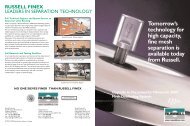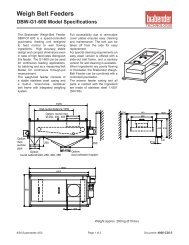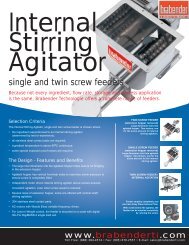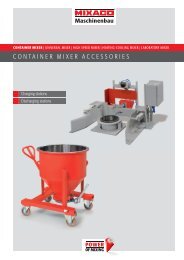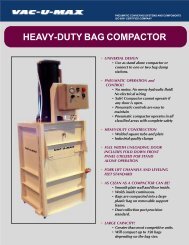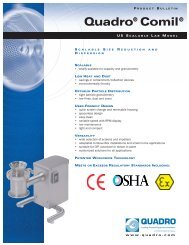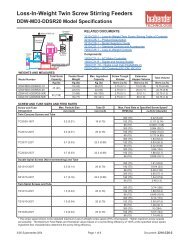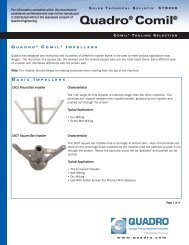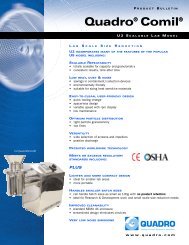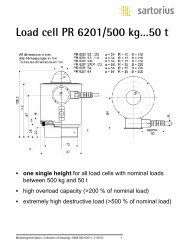HST Mixer Flyash Pow.. - Sawyer/Hanson Innovations
HST Mixer Flyash Pow.. - Sawyer/Hanson Innovations
HST Mixer Flyash Pow.. - Sawyer/Hanson Innovations
Create successful ePaper yourself
Turn your PDF publications into a flip-book with our unique Google optimized e-Paper software.
Reprinted from <strong>Pow</strong>der and Bulk Engineering, July 2001<br />
www.powderbulk.com<br />
Case history<br />
Blender<br />
dedusts fly<br />
ash with<br />
minimal<br />
moisture to<br />
cut transport<br />
costs<br />
A coal-burning electric<br />
power plant installs a<br />
blender to dedust fly ash<br />
and decrease its disposal<br />
costs.<br />
Birchwood <strong>Pow</strong>er Partners<br />
(BPP) operates a 220-megawatt<br />
coal-burning electric<br />
power plant in King George, Va. The<br />
bituminous coal, which is mined from<br />
West Virginia, is transported to the<br />
plant for storage prior to use. The coal<br />
is then charged into the plant’s furnace<br />
where it’s burned to create heat. The<br />
coal-burning process leaves the byproduct<br />
fly ash. Water tubes that pass<br />
through the furnace are heated by the<br />
burning coal, creating high-pressure<br />
steam that spins the plant’s turbines<br />
and generates electricity. A high-velocity<br />
hot airstream conveys the fly<br />
ash from the furnace’s outlet to a baghouse<br />
where the ash is collected before<br />
conveying to a 1,200-ton silo.<br />
The filtered air discharges from an exhaust<br />
stack. The fly ash is then discharged<br />
from the silo and transported<br />
to a landfill for disposal.<br />
High costs of fly ash disposal<br />
Prior to 1998, the plant was used as an<br />
intermediate capacity facility; it went<br />
online only when electricity demand<br />
was high. But since 1998, the plant has<br />
been operating at a higher capacity to<br />
meet the area’s electricity demands.<br />
“So in those two years, we went from<br />
generating an easily manageable<br />
amount of fly ash to generating a significant<br />
amount of fly ash,” says Bob<br />
Snell, material handling manager at<br />
BPP’s plant in King George, Va.<br />
Initially, the company loaded the dry<br />
fly ash into pneumatic railcars that<br />
transported it to an ash processing facility<br />
near Richmond, Va., about 60<br />
miles away. The facility’s operators<br />
discharged the fly ash from the railcars<br />
and processed it through a pug<br />
mill, mixing water with it to eliminate<br />
dusting. They then loaded the moist<br />
fly ash into dump trucks, which<br />
hauled it to a landfill.<br />
“As the plant produced more fly ash,<br />
loading it into the pneumatic railcars<br />
became cumbersome and expensive<br />
because of certain logistic issues concerning<br />
the fly ash removal and rail<br />
transport contracts,” says Snell.<br />
The rotary airlock (upper right) feeds 70 to 80 tons of fly ash per hour<br />
into the blending chamber, where moisture is added for dedusting.
The cost was large enough that BPP<br />
quit using the pneumatic railcars and<br />
switched to pneumatic tanker trucks.<br />
While the dry fly ash was still sent to<br />
the Richmond fly ash processing facility,<br />
using trucks cut costs because<br />
the company now paid for only the<br />
actual weight shipped. Yet it was still<br />
paying transportation costs for the<br />
120-mile round trip and processing<br />
and disposal fees to the landfill.<br />
These extra costs led the company to<br />
search for a better way to dispose of<br />
the fly ash. The company petitioned<br />
the county and the state to use the fly<br />
ash as a daily cover at the landfill located<br />
next to its plant, which would<br />
allow BPP to substantially decrease<br />
its fly ash transportation costs.<br />
“We got permission from the county<br />
and the state to use the landfill next to<br />
us.The landfill would use the fly ash<br />
as a daily cover for the trash,” says<br />
Snell. “Just before they shut down at<br />
night they’d cover the trash with a<br />
mixture of fly ash and soil. But to use<br />
the new landfill, we’d have to condition<br />
the fly ash before transporting it<br />
there. That’s when I started looking<br />
for a machine to perform that operation<br />
in-house.”<br />
Searching for the right equipment<br />
Snell had worked with pug mills in<br />
the past and knew that a pug mill typically<br />
adds about 35 to 45 percent<br />
moisture to dedust fly ash. Because<br />
the extra water weight would increase<br />
the transportation costs, he wanted a<br />
machine that added only 20 to 25 percent<br />
moisture.<br />
“I already knew about some mixer and<br />
blender companies. But when I started<br />
looking for information about blenders<br />
on the Internet, I came across Scott<br />
Equipment and its <strong>HST</strong> blender,” says<br />
Snell. “After learning about this<br />
blender, I contacted the supplier to talk<br />
with a sales rep for more specific information.<br />
I wanted to know if the supplier<br />
had ever dealt with fly ash and if<br />
this blender could dedust fly ash with<br />
only 20 to 25 percent moisture.”<br />
Snell also talked with four other suppliers<br />
about machine capabilities and<br />
prices, but Scott Equipment was the<br />
only company that offered to run dedusting<br />
tests on the fly ash using only<br />
20 to 25 percent moisture. So in February<br />
1999, Snell rented a truck,<br />
loaded on twenty 55-gallon drums of<br />
fly ash, and drove to Minneapolis.<br />
“The supplier invited me up to its test<br />
facility to test the fly ash and prove what<br />
the blender could do with it. In my<br />
experience, you normally don’t get<br />
that.”<br />
The blender’s eight spray nozzles inject more than 200 gallons of recycled<br />
wastewater per minute and operate independently of each other.
Snell spent 2 days at the supplier’s test<br />
facility testing the fly ash on a scale<br />
model of the blender he was interested<br />
in. The supplier ran 15 to 20<br />
tests with varying amounts of moisture<br />
to show Snell how the blender<br />
operated with different percentages of<br />
water and material feedrates.<br />
After the tests, Snell traveled back to<br />
King George, Va., and presented the<br />
information to the plant manager and<br />
plant engineer. With their approval,<br />
Snell called the supplier and ordered<br />
an <strong>HST</strong> blender, along with a rotary<br />
airlock to regulate the fly ash feedrate<br />
from the silo to the blender.<br />
The blender<br />
The <strong>HST</strong> blender is suited for continuously<br />
mixing a small amount of liquid<br />
with a large amount of dry<br />
material. The unit’s three main components<br />
are a structural steel frame,<br />
the blender vessel, and an optional rotary<br />
airlock. The structural steel frame<br />
supports the blender vessel and its<br />
motor. The rotary airlock bolts onto<br />
the blender’s inlet and controls the<br />
material feedrate from the silo into the<br />
blending chamber.<br />
The blender is 13 1 ⁄2 feet long, 90<br />
inches wide, and about 8 feet tall from<br />
the floor to the rotary airlock’s top.<br />
The blender is constructed of carbon<br />
steel but can be constructed of other<br />
materials to suit the application requirements.<br />
The blender’s cylindrical blending<br />
chamber is 30 inches in diameter and<br />
120 inches long. A solid carbon steel<br />
shaft supported by two outboard pillow<br />
block bearings runs the length of<br />
the blending chamber. A 100-horsepower,<br />
explosion-proof electric<br />
motor rotates the shaft, and graphite<br />
packing glands prevent fly ash from<br />
leaking out around the shaft.<br />
Carbide hard-faced carbon steel<br />
beater blades are threaded into the<br />
shaft in a helical pattern, like a screw<br />
thread that continuously wraps or spirals<br />
around a shaft. The beater blades<br />
direct the material through the blending<br />
chamber and provide full blender<br />
wall coverage, eliminating material<br />
buildup in the blending chamber.<br />
Because the beater blades are threaded<br />
into the shaft, the pitch of each beater<br />
blade can be adjusted to direct the material<br />
flow through the blending chamber.<br />
While most beater blades are<br />
pitched to direct the material to the<br />
blender’s discharge, others can be<br />
pitched flat to hold the material or<br />
pitched in reverse to direct the material<br />
back to the blender’s inlet, providing<br />
a longer material retention time.<br />
After working its way through the<br />
blending chamber, the material exits<br />
through the discharge at the blending<br />
chamber’s bottom. The material discharges<br />
by gravity, with no restraining<br />
gate.<br />
One of the problems in handling fly<br />
ash is that it’s very free-flowing;<br />
sometimes it acts just like water. To<br />
address this problem, the supplier<br />
added a rotary airlock to the blender<br />
to meter the fly ash at a controlled rate<br />
into the blending chamber.<br />
One of the problems in handling fly<br />
ash is that it’s very free-flowing;<br />
sometimes it acts just like water. To<br />
address this problem, the supplier<br />
added a rotary airlock to the<br />
blender to meter the fly ash at a<br />
controlled rate into the blending<br />
chamber.<br />
The rotary airlock is 45 inches wide,<br />
45 inches long, and about 32 inches<br />
tall, and it weighs just over 1,500<br />
pounds. A 3-horsepower electric<br />
motor rotates the airlock’s rotor at 20<br />
rpm and meters 4 cubic feet of material<br />
per revolution into the blending<br />
chamber (about 70 to 80 t/h). Both the<br />
shaft motor and rotary airlock motor<br />
are powered by a 460-volt, threephase<br />
power source. The motors<br />
An operator controls the blender’s<br />
operation with an Allen-Bradley<br />
control panel (far right).<br />
work independently of each other.<br />
To dedust the fly ash during blending,<br />
the supplier added an external 2-inchdiameter,<br />
high-pressure water spray<br />
line with eight independently operating<br />
1-inch spray nozzles. The spray<br />
line crosses the blending chamber’s<br />
top, and the spray nozzles are spaced<br />
8 inches apart. The nozzles are<br />
threaded into predrilled holes and<br />
mounted flush with the blending<br />
chamber’s interior wall.<br />
The nozzles spray water in a coneshaped<br />
pattern into the blending<br />
chamber, spreading the water out like<br />
a spotlight. Each nozzle has a valve<br />
that allows an operator to shut it off,<br />
allowing the operator to determine<br />
where the water will be added in the<br />
chamber during blending. This also<br />
allows the operator to better control<br />
the fly ash’s moisture because there<br />
are no moisture content controls inside<br />
the blending chamber; it’s all<br />
done manually.<br />
Three 10-by-41-inch doors — two on<br />
one side of the blending vessel and<br />
one on the other — allow easy access<br />
for maintenance and cleaning.<br />
Dedusting fly ash with less<br />
moisture<br />
In May 1999, the blender and rotary<br />
airlock arrived at BPP’s plant. Prior to<br />
installation, the company bolted the<br />
rotary airlock to the blender’s top.<br />
After installing the blender, the company<br />
connected the blender’s water<br />
spray line to a water source and con-
nected its operating components to an<br />
already-present Allen-Bradley control<br />
panel, which controls the<br />
blender’s operations.<br />
The company installed the blender inside<br />
its fly ash silo under the silo’s discharge.<br />
The control panel is located<br />
near the blender in the same room.<br />
The company also has a remote control<br />
panel in a control room underneath<br />
the blending room, where an<br />
operator can watch each truck as it’s<br />
being filled and shut down the blender<br />
when the truck reaches capacity.<br />
A knife gate, which is connected to<br />
the control panel, charges the fly ash<br />
in the silo to the rotary airlock. To start<br />
the blending process, an operator<br />
turns on the blender and rotary airlock<br />
and then opens the knife gate, allowing<br />
the fly ash to flow. As soon as the<br />
knife gate opens, the spray line automatically<br />
kicks in.<br />
The blender uses 200 gallons of recycled<br />
wastewater per minute — about<br />
35,000 to 50,000 gallons each day —<br />
to dedust the fly ash. When the fly ash<br />
discharges from the blender, a telescoping<br />
chute directs it into a dump<br />
truck.<br />
“We process approximately seventy<br />
tons of fly ash per hour. And we average<br />
about 22 percent moisture content<br />
in the fly ash when it discharges from<br />
the blender. That’s an average, because<br />
the moisture content is affected by humidity,<br />
heat, and wind,” says Snell.<br />
“The fly ash discharges into a regular<br />
dump truck. The driver has about a tenminute<br />
run to the landfill and then<br />
comes back for another load.”<br />
The blender’s ability to dedust the<br />
fly ash with only 20 to 25 percent<br />
moisture reduced the fly ash’s<br />
transportation weight and the<br />
company’s overall transportation<br />
costs more than a pug mill could at<br />
35 to 45 percent moisture.<br />
An important factor in maintaining a<br />
trouble-free blending operation is<br />
keeping the blender clean and following<br />
a regular maintenance schedule.<br />
“We take care of the blender ourselves<br />
because it’s a very simple machine<br />
to maintain. We clean it at the<br />
end of each day. It only takes about<br />
fifteen minutes,” says Snell. “To<br />
clean it, we flush the blending chamber<br />
with water, which gets out the<br />
bulk of the material. Then we open<br />
the three access doors and knock<br />
away any remaining material with a<br />
high-pressure power washer. Other<br />
than that, we grease the blender’s two<br />
pillow block bearings with regular<br />
machine grease once each month.”<br />
Reducing fly ash disposal costs<br />
One of the main benefits the company<br />
has experienced since installing the<br />
blender is the reduction in its fly ash<br />
disposal costs. The blender’s ability<br />
to dedust the fly ash with only 20 to 25<br />
percent moisture reduced the fly ash’s<br />
transportation weight and the company’s<br />
overall transportation costs<br />
more than a pug mill could at 35 to 45<br />
percent moisture.<br />
“We still have the county and landfill<br />
fees, but we’ve eliminated processing<br />
fees and cut down on transportation<br />
costs. When you pay by the ton for<br />
transportation, the less water you<br />
have to put in the fly ash, the less it<br />
costs you to transport it,” says Snell.<br />
“And because we recycle the wastewater<br />
from our plant, we don’t have<br />
any extra costs involved with that.”<br />
Snell bought 10 extra beater blades<br />
with the blender just in case one broke<br />
during operation, but so far none of<br />
them have broken. “The blender has<br />
been in operation just over two years<br />
now, and we’ve processed more than<br />
229,000 tons of fly ash through it,”<br />
Snell says. “We’ve had no maintenance<br />
failures or problems. We just pulled all<br />
sixty-eight beater blades out and I noticed<br />
a little wear on them — only<br />
about 3 ⁄8 inch of wear in two years,<br />
though. I’ll probably replace them all<br />
next summer.”<br />
“One reason we went with this blender<br />
is because it’s a mid-price machine. I<br />
looked at other blenders, and the suppliers<br />
wanted four times what we paid<br />
for this one,” says Snell. “Another<br />
thing that impressed me was that Scott<br />
Equipment invited me up to its test facility<br />
to test the fly ash and prove what<br />
the blender could do with it. In my experience,<br />
you normally don’t get that<br />
— you buy the blender, put it in, and<br />
then you make it work.”<br />
Snell says the blender also installed<br />
the way the company said it would.<br />
“As soon as we had power to it, we<br />
started using it. It has a very low<br />
learning curve, and the guys got used<br />
to it right away. And if something<br />
ever happens to the blender that we<br />
can’t repair, the supplier has a field<br />
service technician who will come out<br />
and look at it.”<br />
PBE<br />
Scott Equipment Co., New Prague,<br />
MN<br />
952-758-2591<br />
www.scottequipment.com




